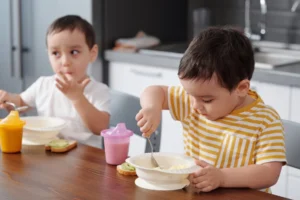How to choose the best primary school for your child is one of the most important decisions you’ll make. It shapes how they think, feel, and learn. As Indian parents, you want the right mix of care, learning, and fun.
But the process can feel confusing. Should you look at academics or activities?
What is the best age to start? Don’t worry. In this blog, you’ll discover 7 simple steps to help you make the right choice with confidence.
1. Understand Your Child’s Learning Style
Some kids love talking. Others like drawing or building things. Every child is different. Watch what your child enjoys. A school that matches your child’s way of learning will help them grow faster.
2. Know the Curriculum Style
In early years (Nursery to Class 5), schools may follow different teaching styles—like play-based, Montessori, activity-based learning, or they may start following CBSE, ICSE, or international curriculums. Ask what your child will be taught and how. Some schools use books early. Some focus on stories and play. Choose what fits your values and your child.
3. Think About Location and Travel
Children should not travel for long hours. Choose a school that is nearby or has safe and clean transport. A short travel time gives your child more rest and play.
4. How to Choose the Best Primary School for Your Child by Visiting the Campus
Brochures are not enough. Go visit the school. Look at the classrooms, toilets, play area, and safety. Watch how teachers treat children. Are they kind? Are the kids smiling? These things matter.
5. Talk to Teachers and Management
Teachers play a big role in your child’s early years. Ask how many kids are in one class. Small classes help each child get attention. Also, talk to the principal. Are they open to parents’ questions? Good management builds good schools.
6. Ask About Extra Activities
Children should play, sing, paint, and dance. Ask if the school gives time for games, art, music, or yoga. These activities help with your child’s full development. A good school cares about more than marks.
7. Be Clear About Fees and Extras
Ask for full fee details. Include transport, books, lunch, and uniforms. Ask if fees increase every year. Some schools show one amount first and later ask for more. Make sure everything is clear and fits your budget.

How to choose the best primary school for your child starts with looking at what really matters—safety, friendly teachers, and a fun place to learn. Visit a few schools, ask questions, and see how your child reacts. Do they feel happy and comfortable? Every child is different, so it’s important to find a school that fits your child’s unique needs. Take your time—it’s okay to think it through. Just by asking how to choose the best primary school for your child, you’re already making a caring and smart choice.
Conclusion
Now you know how to choose the best primary school for your child. Don’t rush. Visit schools. Talk to other parents. Ask questions. Your child needs a place where they feel happy, safe, and excited to learn.
FAQs
Q1: What is the best age to join primary school?
Age 5 or 6 is best for Class 1. Before that, kids go to preschool or kindergarten.
Q2: What’s the difference between CBSE and ICSE in early years?
In early years, the board matters less than the teaching method. CBSE is more structured. ICSE schools focus more on language and writing.
Q3: When should I apply for admission?
Start at least 6 months before the school year. Some top schools close forms fast.
Q4: What documents do I need for admission?
Birth certificate, ID proof, photos, vaccination record, and address proof.
Q5: Can I trust school rankings or online reviews?
They help, but always visit the school and talk to parents.
Q6: How to choose the best primary school for your child if you’re new to the area?
Start by asking local parents, visiting nearby schools, and checking online reviews. Look for a safe, friendly, and engaging environment.
Q7. What factors matter most when learning how to choose the best primary school for your child?
Consider teacher quality, classroom size, school values, learning style, and how well the school supports emotional and social growth.




